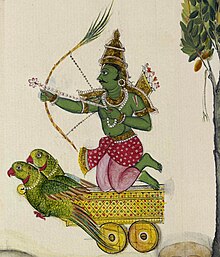
Back كامديفا Arabic কামদেৱ Assamese कामदेव Bihari কামদেব Bengali/Bangla འདོད་པའི་དབང་ཕྱུག Tibetan Kamadeva Catalan Kamadeva CDO Kama (hinduisme) Danish Kamadeva German Kamadevo Esperanto
| Kamadeva | |
|---|---|
God of Love, Desire, Pleasure and Beauty | |
 A gouache painting of Kamadeva, circa 1820 | |
| Other names | Manmatha, Madana, Ananga |
| Devanagari | कामदेव |
| Sanskrit transliteration | Kāmadeva |
| Affiliation | Deva |
| Abode | Kamaloka |
| Mantra | काम (kāma)[1] |
| Weapon | Sugarcane bow and floral arrows |
| Symbol | Makara |
| Mount | Parrot |
| Texts | Atharvaveda, Ramayana, Mahabharata, Harivamsha, Puranas |
| Gender | Male |
| Personal information | |
| Parents | Brahma (father)[a] |
| Consort | Rati[b] |
| Children | Harsha and Yasha (sons) |
| Equivalents | |
| Greek equivalent | Eros[6] |
| Roman equivalent | Cupid[5] |
Kama (Sanskrit: कामदेव, IAST: Kāmadeva), also known as Kamadeva and Manmatha, is the Hindu god of erotic love, desire, pleasure and beauty, often portrayed alongside his consort and female counterpart, Rati. He is depicted as a handsome young man decked with ornaments and flowers, armed with a bow of sugarcane and shooting arrows of flowers.[7]
The Atharva Veda regards Kamadeva as the wielder of the creative power of the universe, also describing him to have been "born at first, him neither the gods nor the fathers ever equaled".[8] Mentioned as a manasaputra (mind-born son) of the creator god Brahma in the Puranas, Kamadeva's most popular myth is his incineration by Shiva's third eye while the latter was meditating, and later embodied on earth as the eldest son of Krishna and his chief consort Rukmini, Pradyumna.[9]
- ^ Kāṇe, Pāṇḍuraṅga Vāmana; Institute, Bhandarkar Oriental Research (1958). History of Dharmaśāstra.
- ^ Cite error: The named reference
VM2was invoked but never defined (see the help page). - ^ Cite error: The named reference
Hopwas invoked but never defined (see the help page). - ^ a b Chandra, Suresh (November 7, 1998). Encyclopaedia of Hindu Gods and Goddesses. Sarup & Sons. ISBN 9788176250399 – via Google Books.
- ^ a b Cite error: The named reference
WWwas invoked but never defined (see the help page). - ^ James Lochtefeld (2002), The Illustrated Encyclopedia of Hinduism, Volume 1, Rosen Publishing, New York, ISBN 0-8239-2287-1, page 340
- ^ Sanford, A.W. (2005). "Shifting the Center: Yakṣas on the Margins of Contemporary Practice". Journal of the American Academy of Religion. 73 (1): 89–110. doi:10.1093/jaarel/lfi005.
- ^ Webster, David (2004-12-31). The Philosophy of Desire in the Buddhist Pali Canon. Routledge. p. 56. ISBN 978-1-134-27941-8.
- ^ Hudson, D. Dennis (2008-09-25). The Body of God: An Emperor's Palace for Krishna in Eighth-Century Kanchipuram. Oxford University Press, USA. p. 417. ISBN 978-0-19-536922-9.
Cite error: There are <ref group=lower-alpha> tags or {{efn}} templates on this page, but the references will not show without a {{reflist|group=lower-alpha}} template or {{notelist}} template (see the help page).
© MMXXIII Rich X Search. We shall prevail. All rights reserved. Rich X Search